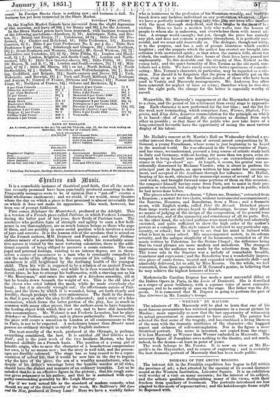Mr. Hullah's concert at St. Martin's Hall on Wednesday derived
a pe- -culler interest from the production of several sacred compositions by M. Gounod, a young. Frenchman, whose name isjust beginning to be heard in the musical world. He was educated in tine Conservatoire of Paris ; and has-since, we understand, pursued along course of artistic studylioth -in. Italy and Germany, without having, for more than ten years, even at- tempted to bring himself into public ,notice,,—an extraordinary circum- stance in this "go-ahead" age. At length, it seems, his genius was ac- oklentally discovered by Madame Viardot ; who is about to perform. the principal part. in Sappho, an opera written by him under her encourage- ment, and accepted at the Academie through her influence. Mr. Hullah, hearing of his Merit, obtained the manuscript Scores of several of his sa- Creel -works, and brought forward some portions of them on this occasion ; the composer himself having come from Paris, not to assist in their pre- 'paration or rehearsal, but simply to hear them performed in public, which he had never done before.
The pieces selected were a chorus, " Libera me, Domino," extracted from a Requiem ; a motett for two choirs, without instrumental accompaniment ; the Sanctus, Hosanna, and Benedictus, from a Maas ; and a dramatic sccnb, with English words, called Peter the Hermit. Detached pieces from large works are always heard to disadvantage, because they afford no means of judging of the design of the composition, of its general tone and character, and of the symmetry and consistency of all its parts. But, on the other hand, the selected portions were most carefully and admirably executed, and quite Sufficient to show the high order of the author's powers as a composer. His style cannot be referred to any particular age, country, or school.; but it is easy to see that his mind is imbued with whatis best in every school. His unaccompanied motett, in its solemn eeverity, anctthe antique simplicity of its harmonies, reminded us of the music written by Palestriva for the Sistine Chapel ; the difference being that its vocal phrases are more -modern and melodious. The strongest impression on the audience was made by the selections front the Mass. The tenor solo in the SanctuS was a melody- of remarkable breadth, ronirdnese- and expression ;:and the Benedictus was a wonderfully impres- sive piece of canto fermo, treated and expanded with masterly skill—and admirably delivered,let us add, by Miss Kearns. On the whole, we feel warranted, from thede specimens of M. Gounod's genius, in believing that ho may achieve the highest henours of his art.


























 Previous page
Previous page